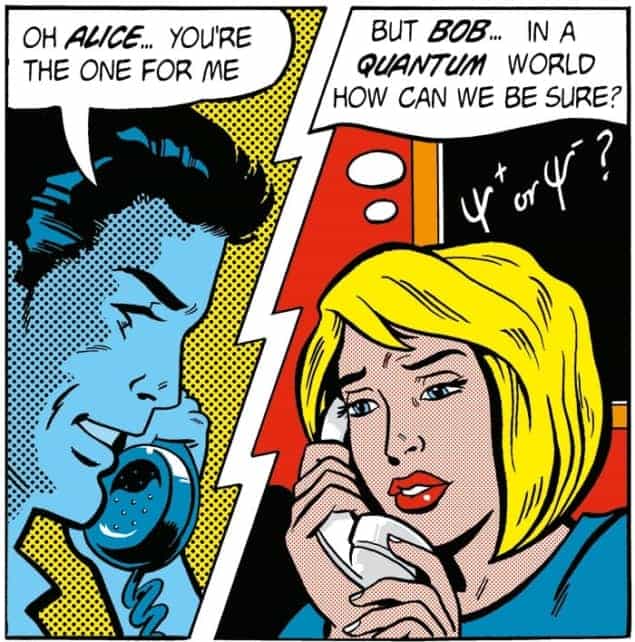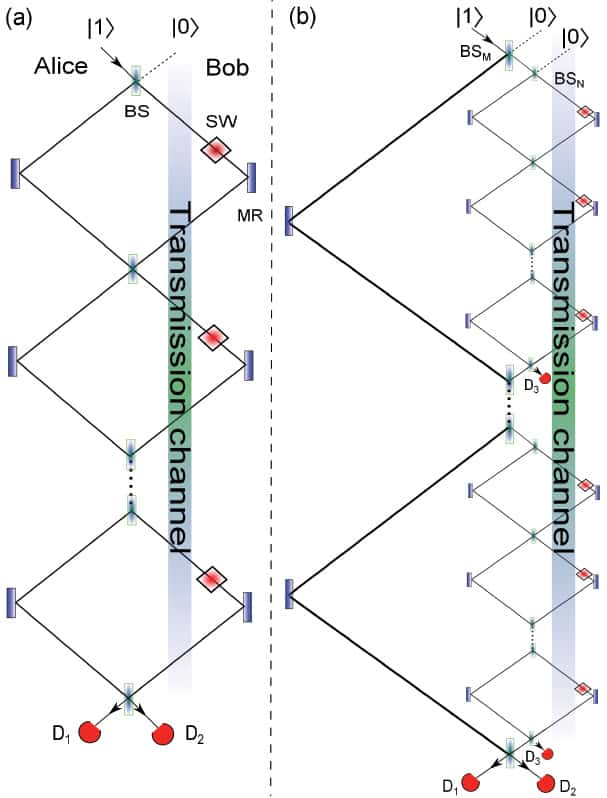
Researchers in Saudi Arabia and the US say that two people equipped with suitable optical devices should in principle be able to exchange information without transferring even a single photon.
The work is based on an idea put forward by Israeli physicists Avshalom Elitzur and Lev Vaidman in 1993 known as interaction-free measurements. This involves using light to detect the presence of an object without actually bouncing any photons off it. Elitzur and Vaidman argued that the wave–particle duality of light dictates that an object obstructing one of two paths inside an interferometer can destroy the interference pattern in that device, even though no photons actually come into contact with it – a hypothesis subsequently confirmed experimentally. Another team of researchers used the principle last year to create a quantum-mechanically encoded key for the encryption and decryption of secret messages.
In the latest work, a team of scientists from the King Abdulaziz City for Science and Technology (KACST) and Texas A&M University (TAMU) aimed to find out whether it was possible to use interaction-free measurements to communicate actual messages rather than simply keys. To do this they used the “quantum Zeno effect”, a phenomenon in which “a watched kettle never boils”. In other words, repeated measurements on a quantum system prevent that system from evolving because of a very high probability that when measured it collapses back into its initial state.
Diamond patterns
At the heart of the system designed by the KACST–TAMU team is a series of highly reflective beam splitters. The idea is that Alice directs a photon at the first beam splitter and Bob has a detector placed behind that device that he can switch on if he wishes to try and detect the photon. With the detector switched off the photon exists in a superposition of both reflecting off and travelling through the beam splitter, which allows it to interfere with itself after bouncing off two suitably positioned mirrors. But with the detector switched on, the photon’s wavefunction is forced to collapse and it follows just one of the two paths.

The second beam splitter is placed at the point where the two paths meet and Bob has a second detector behind that device. With a further two mirrors placed in exactly the same positions relative to the beam splitter and detector and the configuration then repeated, the result is a series of diamond-shaped loops.
Using this set-up Bob is able to tell Alice he has all of his detectors switched on without any photons passing between himself and Alice. With all of the detectors on, the Zeno effect comes into play and the photon’s wavefunction is continually collapsed to the same high-probability state – the reflected one – causing the photon to register a click in one of two output detectors on Alice’s side. Instead, when all of the detectors are off, the repeated self-interference of the wavefunction causes it to evolve and the final state instead triggers the second of Alice’s two detectors.
There is a snag, however. If Bob switches on just one of his more distant detectors, the photon’s wavefunction will have evolved to the point where it is now more likely than not to be found on Bob’s side of the apparatus. In other words, the chances are that he will detect it, defeating the object. To overcome this problem, the researchers inserted a secondary series of loops – each complete with beam splitter, detector and two mirrors – inside every one of the larger loops, leading to what is known as the “chained quantum Zeno effect”. The idea is that these secondary loops reset the wavefunction at the end of each large loop, such that there is never a significant probability of finding the photon in any of Bob’s detectors.
Infinite loops
If physical particles did not carry information between sender and receiver then what did?
Hatim Salih, King Abdulaziz City for Science and Technology
According to the researchers, an infinite number of both primary and secondary loops would guarantee that the photon always triggers the correct detector on Alice’s side and never finishes up in one of Bob’s detectors – so ensuring particle-free communication. Alternatively, they calculate that some 50 primary loops and more than 1000 secondary loops would be needed to trigger the correct detectors 95% of the time. Setting out such a vast number of optical devices with the precision needed to generate a high success rate is in practice impossible, the researchers say, but they were able to design a far more elegant alternative consisting of just one primary and one secondary loop that exploits the superposition of polarizations and which recreates the effect of multiple loops through very precise timing offsets. Team member Suhail Zubairy of Texas A&M University says that the efficiencies and stability of current laboratory technology should yield a success rate of some 70–80%.
Another of the team, Hatim Salih of KACST, says that the group’s approach could be used to carry out secure communications thanks to the absence of a physical signal. But given the method’s significant complexity, it might not appeal to commercial developers. Salih also points out that the team’s paper makes no claim as to how the information travels. “If physical particles did not carry information between sender and receiver then what did?” he adds.
Nicolas Gisin of the University of Geneva says that the work is “quite original, quite clever” and describes the non-physical communication as “very puzzling”. He says that a key challenge will be in quantifying precisely how many photons or fractions of photons are actually transferred from Bob to Alice.
The research is to be published in Physical Review Letters.



